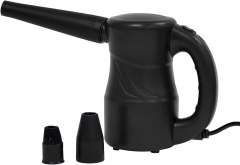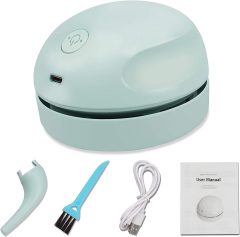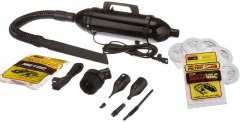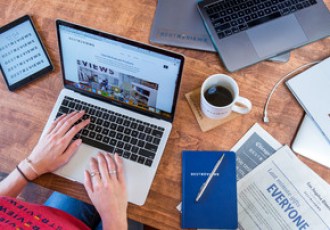BestReviews is reader-supported and may earn an affiliate commission. Details

This duster packs serious power and lots of attachments for a great price.
This duster packs serious power and lots of attachments for a great price.
Features 2 speed settings, 8 nozzle attachments, and a 10-foot power cord to make it easy to maneuver. Very powerful. Casing is made of lightweight but durable ABS plastic.
Some users found it loud.

This battery-powered mini vacuum is designed to get into those tough-to-reach areas.
This battery-powered mini vacuum is designed to get into those tough-to-reach areas.
Easy to use and comfortable to hold. Comes with a detachable vacuum nozzle for getting into crevices such as the keyboard. Includes a USB cord for charging, and a small brush for cleaning the vacuum.
A few customers wished that the suction was a bit more powerful.

One of the most powerful choices for cleaning your desktop.
One of the most powerful choices for cleaning your desktop.
Sturdy steel construction. Has a 19-inch flexible hose. Includes 3 large attachments and a 4-piece micro-cleaning toolkit. Also includes 5 disposable paper bags.
Can easily be damaged if dropped.

A cleaner with a large dust cup and a unique suction design that picks up both large and small particles.
A cleaner with a large dust cup and a unique suction design that picks up both large and small particles.
Provides up to 20 minutes of cord-free clean time. Includes a mini light that provides visibility when cleaning in the dark. The anti-leak design prevents dust and dirt from falling out.
Can take up to 5 hours to get fully recharged.

This portable battery-powered option comes with several attachment nozzles.
This portable battery-powered option comes with several attachment nozzles.
Works well in tight cracks and crevices. Cordless and handheld design makes for quick and easy use. Comes with suction, brush, and flat nozzles. The rechargeable batteries can last for up to 4 hours. Contains a HEPA filter. Mini size is easy to store.
The placement of the power button makes it easy to accidentally turn off while in use.

We recommend these products based on an intensive research process that's designed to cut through the noise and find the top products in this space. Guided by experts, we spend hours looking into the factors that matter, to bring you these selections.

Dust buildup around circuit boards, processors, and power supply can keep a computer from operating efficiently, leading to much higher operating temperatures and possibly slowing performance. Enter the computer vacuum, a convenient appliance for removing dust in a few seconds, saving you from lots of tedious work with a canister of compressed air and a microfiber cleaning cloth.
A computer vacuum is a handheld device with several small, often flexible attachments that make it easy to reach tiny crevices and corners inside a computer’s case or laptop’s air vents. These vacuums are designed to operate around a computer’s sensitive electronics without disrupting them, but not all computer vacuums are the same.
Buyers have a wide choice of models, with different power levels, corded and cordless versions, and various attachments.

To an inexperienced computer user, computer vacuums may seem like an odd choice. Why not just use a household vacuum to clean dust from a computer’s vents or case interior? The reason is that a regular vacuum cleaner can build up quite a static charge on the plastic nozzle during use, and that static can discharge at the worst possible moment, just as the nozzle nears a circuit board, for example. Next thing you know, you’ve got a computer that won’t boot up. And that’s the most important consideration when choosing to use a computer vacuum: it reduces static buildup and prevents an unintended static discharge while using it around electronics.
Suction power is another consideration. Most computer vacuums are handheld units with smaller motors than household vacuums. Power can differ greatly between various models – higher-end models boast 4.5 amps and ample cubic feet per minute (cfm), while lower-priced vacuums may bury these stats because they don’t match the same cfm rating. You need a computer vacuum that will clear dust from the CPU interior, keyboard, or peripherals without damaging the components or hardware.
Take into account how you’ll be using the computer vacuum, too. If you’re cleaning dust bunnies out of neglected computer towers, that takes a tool with more power and vacuum capacity, as well as dust storage. If you just need to clean a laptop’s keyboard and remove dust from its innards via the air vents, a smaller and less-powerful vacuum is your best bet.
And here’s another reason to use a computer vacuum: using compressed air canisters to blow out dust and debris means you’ll be adding spent canisters to the landfill — they can’t be recycled. A computer vacuum can be used many times before needing to be replaced, with a service life far beyond that of a disposable air canister.
Motor: Like other handheld vacuums, computer vacuums are driven by an electric motor. The size and output of the motor can vary, and that will affect the power of the vacuum.
Attachments: Computer vacuums should include a few attachments, such as a hose extension and different nozzle sizes that can reach small, hard-to-access areas of the computer.
Antistatic brush: You’ll want a soft bristle brush that may be fitted as an attachment or as a handheld accessory to loosen dust bunnies from sensitive electronics.
Grounding wire: A few computer vacuum kits include a nozzle attachment with a grounding wire. This can be placed on a surface well away from the component being cleaned so that the static electricity discharges along the grounding wire and not into the electronics.
Two-way setting: This option on many computer vacuums allows you to either vacuum or blow air. Using a blower can be helpful in dislodging dust from tightly packed components without damaging them.
Handle: Look for a computer vacuum with a sturdy handle so you can maintain control of the appliance while shifting it around the computer components.
Shoulder strap: Available on larger models, a strap makes the vacuum easier to carry and can help prevent accidental drops.
Inexpensive: Single-speed handheld computer vacuums start at about $19, though the lower the price, the less powerful the vacuum.
Mid-range: Computer vacuums with more options and accessories are available in the $40 to $50 range.
Expensive: More powerful computer vacuums boasting 4.5 amps or more can be found in the $80 to $105 price range.

Q. I’ve read that using a computer vacuum is risky and can damage circuit boards. Is this true?
A. Static discharge is a constant risk when working around circuit boards, and this can happen in a number of ways, such as touching the board with a finger when there’s a static charge buildup on your clothing. Swiping a board with a cloth can also cause static buildup and discharge. So, a risk exists no matter what cleaning method you use. Of course, another way that a circuit board can be damaged is by accidentally whacking the vacuum nozzle against it. Just move carefully around the computer interior while cleaning, follow the manufacturer’s instructions to prevent static discharge, and it should be fine.
Q. How long will a battery-operated computer vacuum run?
A. That depends on the type of battery. For example, a small handheld using standard AA batteries may give you an hour or two of run time, and gradually lose power as the batteries discharge. A vacuum with a four- or six-cell rechargeable battery may last a shorter or longer time. Check the product specifications for the models you’re considering.
Get emails you’ll love.
Learn about the products you’re wondering if you should buy and get advice on using your latest purchases.
